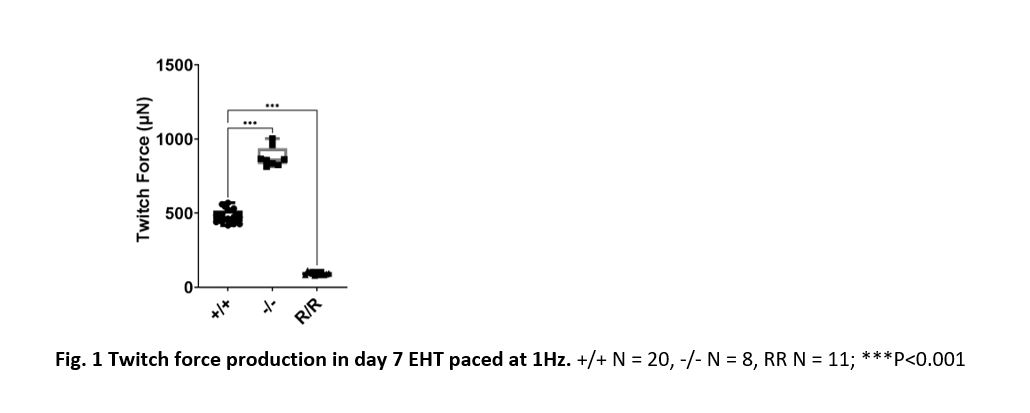Final ID: We051
Chronic mavacamten treatment prevents development of contractile dysfunction in cMyBP-C null engineered heart tissue constructs, but not in constructs carrying the cMyBP-C W792R missense mutation
Abstract Body:
Hypercontractility, caused by mutations that increase the number of myosin heads in the disordered relaxed (DRX) state, is a prevalent cause of hypertrophic cardiomyopathy (HCM). A subgroup of HCM mutations cause primary hypocontractility, by stabilizing super-relaxed crossbridges (SRX). Mavacamten (mava) directly targets hypercontractility by reducing the number of DRX heads and improves outcomes in ~70% patients with obstructive HCM.
We here assessed the efficacy of chronic mava treatment at preventing phenotype development in human iPSC engineered heart tissue (EHT) in a cMyBP-C null model (-/-), that increases the number of DRX heads, and EHT carrying the W792R (RR) HCM mutation. While the primary contractile defect caused by the W792R mutation is unknown, we postulated that it differed from the cMyBP-C -/- model, as RR mice die prior to weaning while -/- mice do not.
Twitch force (TF) measurements performed on day 7 on control (+/+), -/- and RR EHT show that -/- EHT were hypercontractile while RR EHT were hypocontractile (Fig. 1). Following measurement, EHT from each genotype were either treated with vehicle or 100nM mava and cultured for 21 days. By day 28, TF production was similar between +/+ and -/- vehicle treated EHT while RR EHT remained hypocontractile (Fig. 2). Chronic mava treatment significantly reduced TF production in +/+ EHT but not in -/- or RR EHT (Fig. 2). Consistent with diastolic dysfunction, a hallmark of HCM in humans, day 28 -/- and RR EHT displayed slow relaxation, though the effect was more pronounced in RR EHT (Fig. 3). While chronic mava treatment accelerated relaxation in -/- EHT to levels that were similar to that observed in vehicle treated +/+ EHT, it failed to do so in RR EHT (Fig. 3).
cMyBP-C -/- EHTs initially present with a hypercontractile phenotype, consistent with an increase in DRX crossbridges, while W792R RR EHT present with a hypocontractile phenotype. By 4 weeks in EHT culture, both genotypes present with impaired relaxation, that is more severe in RR EHT. While chronic mava treatment prevents development of slow relaxation in -/- EHT, it failed to do so in RR EHT. These findings suggest that the primary disease mechanism of the W792R mutation is not an increase in DRX crossbridges and that mavacamten may not be an effective treatment for patients carrying this mutation, further highlighting the need for studying the pathomechansims of HCM mutations and the development of novel therapies.
Hypercontractility, caused by mutations that increase the number of myosin heads in the disordered relaxed (DRX) state, is a prevalent cause of hypertrophic cardiomyopathy (HCM). A subgroup of HCM mutations cause primary hypocontractility, by stabilizing super-relaxed crossbridges (SRX). Mavacamten (mava) directly targets hypercontractility by reducing the number of DRX heads and improves outcomes in ~70% patients with obstructive HCM.
We here assessed the efficacy of chronic mava treatment at preventing phenotype development in human iPSC engineered heart tissue (EHT) in a cMyBP-C null model (-/-), that increases the number of DRX heads, and EHT carrying the W792R (RR) HCM mutation. While the primary contractile defect caused by the W792R mutation is unknown, we postulated that it differed from the cMyBP-C -/- model, as RR mice die prior to weaning while -/- mice do not.
Twitch force (TF) measurements performed on day 7 on control (+/+), -/- and RR EHT show that -/- EHT were hypercontractile while RR EHT were hypocontractile (Fig. 1). Following measurement, EHT from each genotype were either treated with vehicle or 100nM mava and cultured for 21 days. By day 28, TF production was similar between +/+ and -/- vehicle treated EHT while RR EHT remained hypocontractile (Fig. 2). Chronic mava treatment significantly reduced TF production in +/+ EHT but not in -/- or RR EHT (Fig. 2). Consistent with diastolic dysfunction, a hallmark of HCM in humans, day 28 -/- and RR EHT displayed slow relaxation, though the effect was more pronounced in RR EHT (Fig. 3). While chronic mava treatment accelerated relaxation in -/- EHT to levels that were similar to that observed in vehicle treated +/+ EHT, it failed to do so in RR EHT (Fig. 3).
cMyBP-C -/- EHTs initially present with a hypercontractile phenotype, consistent with an increase in DRX crossbridges, while W792R RR EHT present with a hypocontractile phenotype. By 4 weeks in EHT culture, both genotypes present with impaired relaxation, that is more severe in RR EHT. While chronic mava treatment prevents development of slow relaxation in -/- EHT, it failed to do so in RR EHT. These findings suggest that the primary disease mechanism of the W792R mutation is not an increase in DRX crossbridges and that mavacamten may not be an effective treatment for patients carrying this mutation, further highlighting the need for studying the pathomechansims of HCM mutations and the development of novel therapies.
More abstracts on this topic:
Advancing Personalized Medicine through Enhanced Heart-on-Chip Models Incorporating iPSC-Derived Immune Cells
Mozneb Maedeh, Arzt Madelyn, Moses Jemima, Escopete Sean, Sharma Arun
A-band titin-truncating variant promotes the development of arrhythmia-induced cardiomyopathy in a novel genetically-engineered porcine modelLee Kwonjae, Del Rio Carlos, Mcnally Elizabeth, Pfenniger Anna, Bhatnagar Ashita, Glinton Kristofor, Burrell Amy, Ober Rebecca, Mcluckie Alicia, Bishop Brian, Rogers Christopher, Geist Gail



